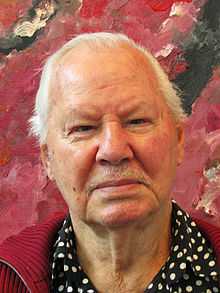Armando (artist)
- For the online writer/blogger, see Daily Kos.
Herman Dirk van Dodeweerd [1] (born September 18, 1929), known as Armando, is a Dutch painter, sculptor and writer.


Biography
Armando was born in Amsterdam, and as child moved to Amersfoort. There he saw, during the German occupation of the Netherlands, how the Nazis set up a "transition camp" for prisoners who were to be sent to concentration camps. The suffering of the victims and the cruelty of the Nazi camp guards, so near his home, influenced him for the rest of his life. After the liberation (1945), he studied art history at the University of Amsterdam.
His first solo exhibition was at the Galerie Le Canard, Amsterdam, in 1954. At this time he also started to write poetry. He was influenced by the CoBrA art group, and made abstract drawings—with his left hand, in the dark. He was also influenced by Dubuffet and Jean Fautrier, producing thickly impastoed paintings.
In 1957 he was one of the founder-members of the Nederlandse Informele Groep (Informelen), with the painters Kees van Bohemen (nl), Jan Henderikse (nl), Henk Peeters, Jan Schoonhoven (nl) and others.
By 1959 he had joined the Situationist International (SI) and attended their Third conference, held in Munich April 17–20, 1959. With Anton Alberts, Constant and Har Oudejans he wrote First proclamation of the Dutch Section of the SI. However, he was expelled from the SI in the Spring of 1960, though continuing to contribute to other Situationist publications like the Situationist Times. He has also contributed to Podium, Gard Sivik, De Nieuwe Stijl, and Barbarber.
He lived partly in Amsterdam, partly in Amersfoort, and until 1989 also in Berlin.
Fire at the Armando museum, 2007
Amersfoort, the place of his childhood, hosted a museum devoted to his work. On October 22, 2007, a large fire struck the museum and burned thirteen Armando paintings. At the time of the fire there was also an exhibition with works of painters like Ruisdael, Dürer, Seghers and Kiefer, which were all lost, with damages estimated at about three million euros (US$ 4,000,000). (Source: Dutch TV News NOS, October 24, 2007) A final balance of the damage by the fire was made on Tuesday November 20, 2007. According to a Dutch newsarticle, 63 paintings were lost, 8 were recovered. 6 of the recovered paintings are badly damaged, two are lightly damaged.[2]
Honours and awards
Honours
- 1990 - Knight of the Order of Oranje-Nassau
- 2006 - Knight of the Order of the Netherlands Lion
- 2009 - The Honorary medal for Arts and Science of the Order of the House of Orange[3]
Awards
- 1977 - The Herman Gorter prize for his collection of poetry Het gevecht.
- 1984 - The Ferdinand Bordewijk Prize for his essay Machthebbers, verslagen uit Berlijn en Toscane.
- 1984 - The Multatuli prize for his essay Machthebbers, verslagen uit Berlijn en Toscane.
- 1985 - The 1st Jacobus van Looy prize.
- 1987 - The Gouden Ganzenveer voor his contribution to the Dutch culture and the distribution throughout Europa.[4]
- 1989 - The Multatuli prize for his essay De straat en het struikgewas.
References
| Wikimedia Commons has media related to Armando. |
- ↑ Armando (August 1997). From Berlin. Hushion House. ISBN 978-0-948462-87-0.
- ↑ "Armandomuseum verliest 63 schilderijen | nu.nl/algemeen | Het laatste nieuws het eerst op". Nu.nl. Retrieved 2013-07-18.
- ↑ NRC, 10 december 2009
- ↑ "Laureaten De Gouden Ganzenveer vanaf 1955". Stichting De Gouden Ganzenveer. 2009. Retrieved 2009-07-28.